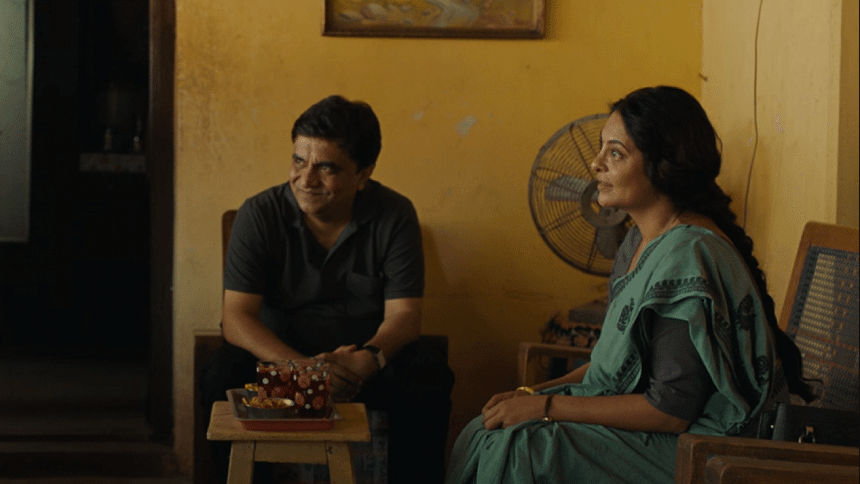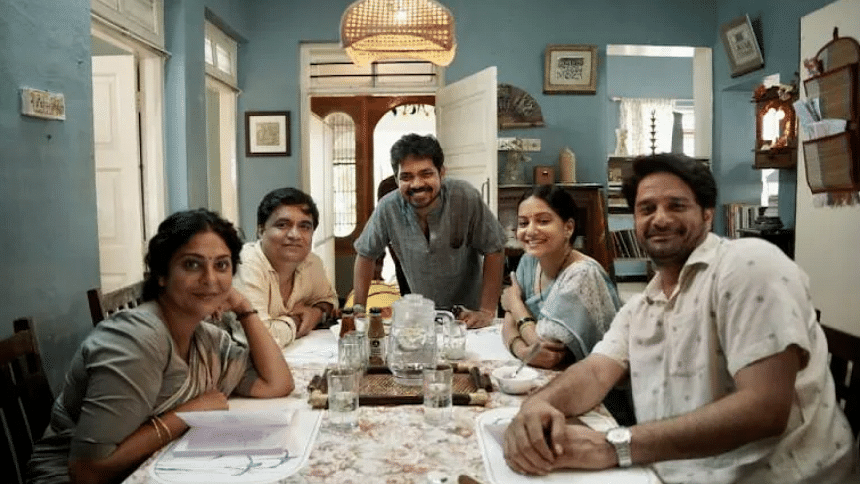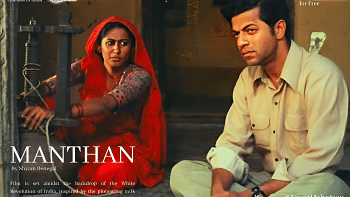‘Three of Us’: Of redemption and memories

The morning dawns, darkness not yet fully dispelled, and the sound of crickets persists. Shailaja (played by Shefali Shah) walks alone, silently, her footsteps echoing through the narrow path that leads to the home she left in Kokan, where her childhood memories lie buried. She stands by the well, the same well where she lost her childhood playmate, her sister. For a brief moment, she stands there, as if preserving her 28-year-old memories. Then, with a heavy heart, she resumes her journey. As the curtains fall on this tragic film, the aforementioned final moment of "Three of Us" embodies a profound transformation, akin to a decree of tragic poetry.
It begins in bustling Mumbai, where a middle-aged couple grapples with their mundane life — Shailaja's husband, Dipankar (played by Swanand Kirkire) working tirelessly yet remaining steadfastly by her side, while she battles dementia. They receive a warning from the doctor implying that her memories will gradually fade away. It possibly triggers Shailaja to propose returning to Vengurla, Kokan; the place she had left behind 28 years ago. She then returns to the streets of Kokan with the hope of reconnecting with her past. In due course, she also visits the previously mentioned well, which holds much significance to the younger Shailaja. Her life as a kid revolved around Pradip (Jaideep Ahlawat), Gayatri (Rasika Agashe), and Parshuram (Dhruv Chavan), whose lives were far from content.

The film further delves into the lives of other characters—Gayatri (Rasika Agashe) and Sarika Kamat (played by Kadambari Kadam). Gayatri's limited screen time leaves a lasting impression, while Sarika's introspective character captivates. The absence of forced flashbacks adds to the film's charm. Instead, we witness Shailaja's childhood memories seamlessly woven into the narrative within 40 seconds. The film leaves us in awe of how the past can resurface without any explicit flashback. Shailaja's pain becomes our own as she struggles to hold onto her memories.
Shailaja's determination to preserve her stories mirrors the human desire for immortality—whether through our creations or our children. "Three of Us" isn't just a film for cinephiles; it's an experience. Its filmmaking, performances, and music resonate deeply. While some connections remain unspoken, the one-on-one conversation between Pradeep and Shailaja by the end holds immense significance. Shailaja's character, haunted by impending dementia, becomes a vessel for recollecting forgotten memories, albeit hopelessly. The film runs on the protagonist's life and story, and everything that will slip away soon, leaving her a memory-less soul. The film masterfully captures the essence of her struggle.
With the poignant tale of "Three of Us", director Avinash Arun crafts a compelling binary tale, a theater of life — vividly portraying the dichotomy between both the urban and rural middle-class struggles. For instance, Shailaja and Dipankar wander the streets of Kokan, while Parashuram's family grapples with the absence of happiness. The film's raw authenticity resonates with audiences, making them witnesses to diverse life perspectives. Shailaja's acceptance of her gradual loss of memories becomes a beacon of a universal experience, compelling viewers to empathise with her plight. The film's power is in its ability to transport audiences beyond the screen.

Avinash, may not yet be a renowned director but he is certainly one of India's most familiar cinematographers. His work in projects like "Pataal Lok", "Drishyam", and "Masaan" has solidified his reputation behind the camera. In "Three of Us", he also shoulders the role of the cinematographer and creates his style in such a way that the frames become a language of their own. This uniqueness of his remains consistent even in this film. Avinash's cinematography creates a world where frames speak louder than words.
The film opens with a scene of Shailaja walking along the streets of Mumbai at night. From the sound of footsteps to the honking taxis, Avinash captures the essence of the city. But the heart of the story lies in Kokan, the place Shailaja left behind. Each frame weaves a narrative, revealing glimpses of their intertwined stories. Wide shots, close-ups, and panning sequences create a visual tapestry that speaks volumes.
As a quiet film "Three of Us" invites the audience to experience the characters from within. Powerful sound design plays a crucial role here. The natural sounds, meticulously crafted by Michel, echo through the film's flow. Suddenly, amidst Mumbai's mechanical life, a glimpse of nature emerges, as if the film itself has stepped into the wilderness. The sound of rain during Parashuram's struggling tale becomes unexpectedly captivating. D Souja's sound design adds depth to the background score. The film's Bharatanatyam dance scene or the composition for a single song—both showcase Michel's ability to immerse viewers in the story. The background music score is hauntingly beautiful.

"Three of Us" transcends screens and gadgets, leaving an indelible impression on the heart. Screenwriters Arpita Chatterjee and Omkar Achyut Barve contribute significantly to the film's narrative. The deliberate juxtaposition of settings and locations in "Three of Us" captures time itself. The rural houses, their surroundings, and the subtle subplots woven into each location create an immersive experience. It feels as though the director has an unspoken connection with these places. Whether it's the natural landscapes or the well where Shailaja once stood, the film breathes life into forgotten memories.
The film is a reminder that sometimes, content speaks louder than appearances. It converges the past and present, leaving an indelible mark on the audience. The dining table in Pradeep's house becomes a silent storyteller. The old mansion, the school, and the conversations within them—all hold a unique charm. The play of light and color adds to the film's allure. The dark, gritty tones of the night scenes create an otherworldly effect. The local artists, without heavy makeup, blend seamlessly into the natural backdrop, making their presence authentic.
Supposedly, on the first day of shooting "Three of Us", Shailaja's character sets the tone. Her message to director Avinash reads, "You know what you're doing, don't you? I'm not entirely sure what I'm supposed to do." The director's response, "I don't know either," — perfectly encapsulates the uncertainty that leads Shailaja to discover herself. As she loses memories day by day, the unfamiliar becomes familiar, and a sense of responsibility settles upon her childhood self.

Shefali Shah's career-defining performance shines through in this film. it doesn't rely on glamorous casting, instead it draws strength from its content. On the other hand, Jaideep Ahlawat, known for his role in "Paatal Lok", embodies Pradip with authenticity and adds depth. Rasika Agashe is equally compelling — her nuanced expressions and minimal dialogue convey volumes. However, it's Kadambari Kadam's portrayal of Sarika, Pradeep's wife, that stands out. The unassuming village girl, lost in her world, is beautifully brought to life by Kadambari. Her eyes, her smile, and her unspoken words—all contribute to the film's quiet magic.
The dining table plays a pivotal role in the lives of people across the subcontinent. The scenes around the dining table, where conversations unfold, resonate with Shailaja's perspective. You will find a mark of the late West Bengal director Rituparno Ghosh in terms of making the dining table vivid. The film presents an extraordinary juxtaposition of the past, subtly illuminating the crises faced by middle-aged couples—where both parents work—and the complexities of their relationships. Avinash subtly warns us about the fragility of memories. Shailaja's desire to preserve her stories, even when she knows her dementia will eventually erase them, reflects the urgency of immortalising her past. The reunion between Shailaja and her childhood friend Pradip at the dining table evokes a sense of contentment.
The film leaves us pondering: for what purpose do we consider something unforgettable? The answer lies in everything. As the film concludes, perhaps each viewer will find a piece of their past intertwined with Shailaja's. As the epilogue scrolls down, a rush of thoughts arises, "Three of Us" beckons, but whose essence truly crystallises as "Three of Us"? Is it Shailaja, Pradip, and Dipankar, or Shailaja, Pradip, and Sarika? Or perhaps the childhood trio: Gayatri, Pradip, and Shailaja's vista?
In the eyes of "Three of Us", myriad tales congregate, and each narrative weaves a tapestry of fate.

 For all latest news, follow The Daily Star's Google News channel.
For all latest news, follow The Daily Star's Google News channel. 








Comments